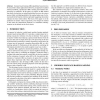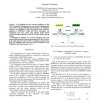DAWAK
2006
Springer
14 years 3 months ago
2006
Springer
This paper describes problem of prediction that is based on direct marketing data coming from Nationwide Products and Services Questionnaire (NPSQ) prepared by Polish division of A...
EUSAI
2004
Springer
14 years 3 months ago
2004
Springer
Pervasive resp. ubiquitous systems use context information to adapt appliance behavior to human needs. Even more convenience is reached if the appliance foresees the user's de...
ECAI
2004
Springer
14 years 3 months ago
2004
Springer
Instance-based learning (IBL) algorithms have proved to be successful in many applications. However, as opposed to standard statistical methods, a prediction in IBL is usually give...
CCGRID
2004
IEEE
14 years 3 months ago
2004
IEEE
Resource prediction can greatly assist resource selection and scheduling in a distributed resource sharing environment such as a computational grid. Existing resource prediction m...
PODC
2010
ACM
14 years 4 months ago
2010
ACM
Large-scale hosting infrastructures require automatic system anomaly management to achieve continuous system operation. In this paper, we present a novel adaptive runtime anomaly ...
CDC
2009
IEEE
14 years 4 months ago
2009
IEEE
This paper is concerned with information theoretic "metrics" for comparing two dynamical systems. Following the recent work of Tryphon Georgiou [1], we outline a predicti...
ASPDAC
2007
ACM
14 years 4 months ago
2007
ACM
- Two challenges for the accurate prediction of GHz CMOS analog/RF building blocks are presented. Challenging the usage of new compact MOSFET models enhances the simulation accurac...
MICRO
1996
IEEE
14 years 4 months ago
1996
IEEE
Branch prediction is the predominant approach for minimizing the pipeline breaks caused by branch instructions. Traditionally, branch prediction is accomplished in one of two ways...
ISCA
1997
IEEE
14 years 4 months ago
1997
IEEE
As processor architectures have increased their reliance on speculative execution to improve performance, the importance of accurate prediction of what to execute speculatively ha...
DCC
1998
IEEE
14 years 4 months ago
1998
IEEE
Multi-hypothesis motion-compensated prediction extends traditional motion-compensated prediction used in video coding schemes. Known algorithms for block-based multi-hypothesis mo...




